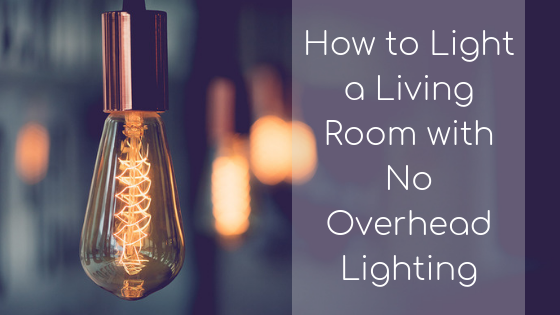
When you rent a place to live, you are often most focused on important details like location, neighbors, community, and other must-have rental features.
But what if, as you move the last box into a new place, you realize that your living room have no overhead lighting?
Lack of overhead lighting occurs in rentals for various reasons. Sometimes, you rent a house that was built a while ago (this style became popular in 1945 and stuck around through the 1980s). Sometimes, an apartment was built in such a way that the ceiling space is taken up by an AC system leaving no room for lights. Or, sometimes, the owner simply decided to save some money on rewiring and decorating. For one reason or another, you may end up living in such place.
What can you do to fix a home that lacks overhead lighting, while still keeping the rental intact and not wasting money on unreliable solutions that you cannot take with you after moving out?
In this article, I will explore options for how to light a rental with no overhead lighting and what to avoid.
How NOT to Light a Living Room
Even though some of these examples might save you time and (a little) money, you will end up sacrificing efficiency, style, and it could end up costing you in the future.
These solutions may also damage the rental property. This means that either the landlord will keep the deposit to fix the damages after you move out or you will have to do repairs yourself.
So, here are options that you should NOT consider when you are trying to light a room with no overhead lighting.
No-go option #1: Battery operated lights
Mounting a battery operated light to your ceiling might seem like a simple, cost saving option to brighten up your space.
Even though these lights are marketed as a wireless remote controlled breeze, the inconvenience they cause are not worth the money you save.First of all, you may no be allowed to make any holes in the ceiling or wall meaning you won’t be able to mount the lights properly.
Battery operated lights tend to be unreliable or dim. Additionally, since there are so many parts involved with this lighting system, you run the risk of losing remotes and dealing with dead batteries.
No-go option #2: LED strip lighting
LED strip lighting is a battery operated alternative to the ceiling mounted options.
For some reason, people have taken to stringing these lights around the corners of their ceiling.
In addition to the annoyances of traditional battery powered lights, LED strip lights can be eyesore. Since this type of lighting is mounted with a sticky tape, you won’t be able to re-use them after you move to a new place and you might end up losing money.
Instead of wasting time on the fixes above, try these options instead!
Three options to light a living room in a rental
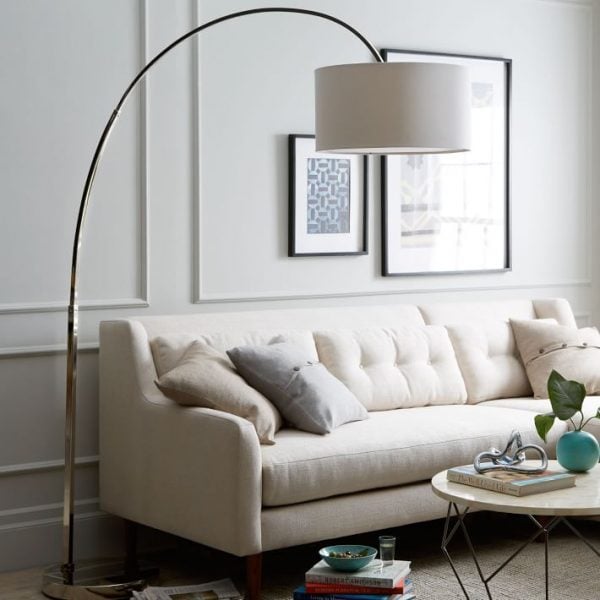
Source: westelm.com
Option 1: Large arc floor lamp
This replacement for an overhead fixture is the simplest way to supplement a living room with no overhead lighting. It comes with some pros and cons:
Large Arc Floor Lamp Pros:
- Stylish and easy all-in-one solution
Large Arc Floor Lamp Cons:
- Not suitable for small places
- Might be harder to move the lamp to a new place due to its heavy base
There are no special steps or installation process needed, so let your creative juices take over.
One thing though: While choosing your arc lamp, make sure that you have enough room in your space for the arch arm.
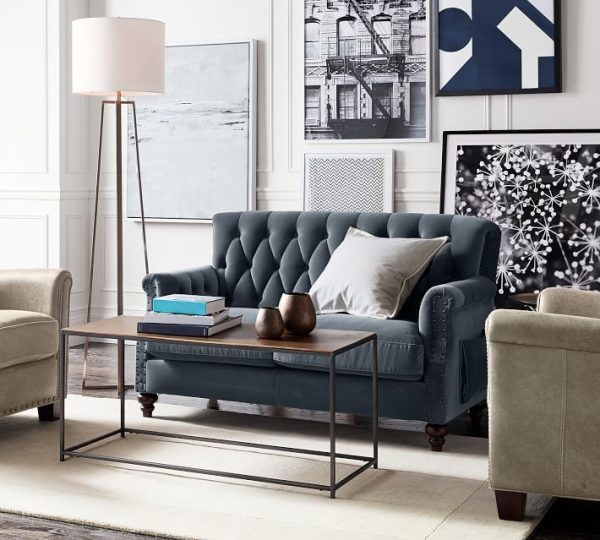
source: potterybarn.com
Option 2: Floor lamps
This option involves placing floor lamps throughout the space to maximize interior lighting. Let’s take a look at the pros and cons of floor lamps.
Floor Lamp Pros:
- Easy to set up and to move to a new place
- Does not take too much room
- Flexible solution that can easily accommodate layouts of various rental places, even the ones that do not have problem with overhead lighting
Floor Lamp Cons:
- Easy to get a cluttered look in a room
How to light a room with floor lamps:
- Estimate the size of your room to see how many floor lamps you need
- The rule of thumb is to have 3 floor lamps to light up all the corners except the one next to the door.
- If you want to do more precise calculations, check the formula in this article by BallarDesign.
- Note where the plugs are located and whether you need extension cables to reach them
- Buy the necessary number of floor lamps and extension cables (if you need any)
- Put up the lamps on the spots and plug them in!
Pro tip: Swap one or two of your floor with matching table lamps for a more versatile solution. You can find many inexpensive light fixture collections that have both floor and table lamps (for example, the Eastview one.)
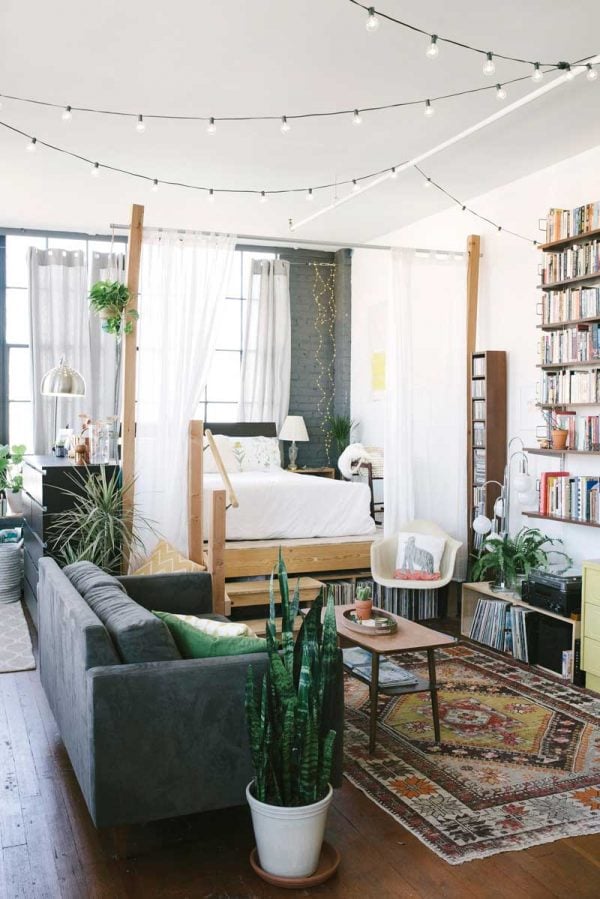
source: designsponge.com
Option 3: String lighting (NOT LED strips)
This option is about hanging pretty string lights under the ceiling. Let’s see its pros and cons.
String Lights Pros:
- Stylish and beautiful lighting arrangement that can put your guests in awe
- Can make the rental place feel like a real home!
- Suitable for both big and small places
String Lights Cons:
- You need to put hooks into ceiling or wall; not every rental allows that! Please ask a permission from your landlord before installing hooks or look for temporary, damage-free mounting options.
- May require some time since it’s not so easy to install.
If the cons are not a problem for you (and, again, your landlord does not mind you putting hooks in walls), let’s dive in into the steps you need to do.
How to light a room with string lights:
- Map out your ceiling
- Draw a sketch of your ceiling and map out where the outlets in the room are
- Plan how you want to hang the lights
- There are tons of design ideas out there
- You could hang around the borders of the ceiling, swag them diagonally, or create different focal points
- Measure out your plan to see the total length needed
- If you are planning on draping your lights, make sure to
- Purchase your lights
- Purchase lights that can be plugged into each other so that your design can flow
- Install hooks in the ceiling
- Hang your lights!
Tips to enhance your lighting solution
Here are a couple of tips that can make your lighting a bit more efficient.
Choose powerful bulbs
To match the brightness overhead lighting offers you will have to use powerful bulbs.
Know that LED or CFL bulbs produce the most light. To understand the difference and pick one best suited for your needs, check out this: Difference Between LED and CFL Bulbs.
Also, if you want your place to be eco-friendly, LED bulbs are considered to be more green than any other types of bulbs.
Set up a remote switch connected to the wall outlet
In order to turn on and off your lights easily, you can connect them all to one remote switch. It sounds a lot more technical than it is!
All you really have to do is choose a wall outlet that has remote controlled technology. You don’t even have to use a “remote” anymore– most of these options can be controlled from your phone!
Final words
Lighting helps set the atmosphere and vibe of our living space. If you are struggling to find lighting solutions for a room with no overhead lighting, it can really be as easy as 1,2,3.
What type of lighting fixtures have worked for your rental home? Let us know in the comments, and share any lighting questions or concerns section below.

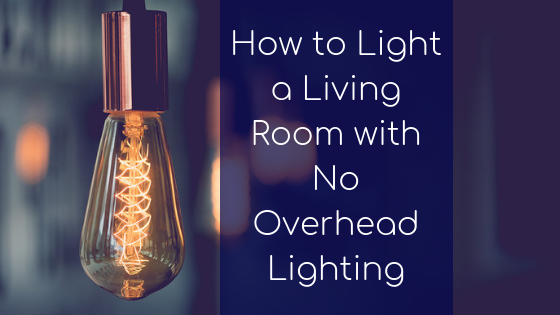





LMFAO So Your advice is not to use any convenient lighting and to use lamps? Lamps? Gee, I am sure NO ONE thought of that. Screw the LED light that leaves a small footprint and lights a room better than a lamp. Let’s hang up Christmas lights lmao
Many apartment dwellers do not have the option to install their own lighting without risking their security deposit. This article was written with those renters in mind that might need options and suggestions as a jumping-off point. Fortunately, energy-efficient bulbs are readily available and easy to find in a variety of lighting options such as lamps and stringed lighting.
Thank you for writing this article
You are very welcome Karthik !